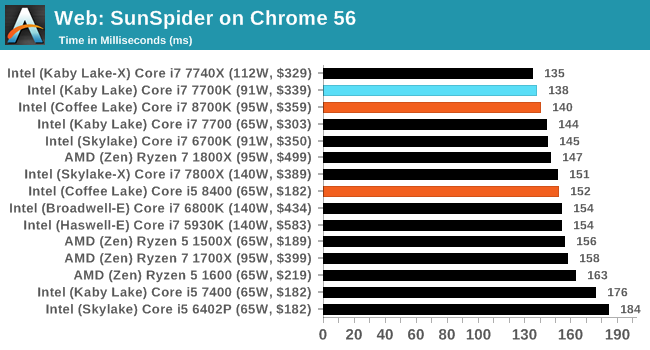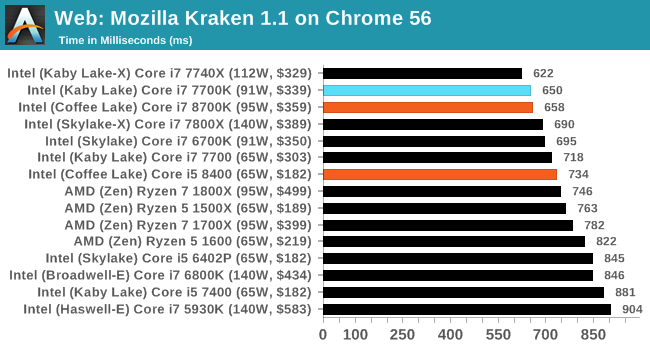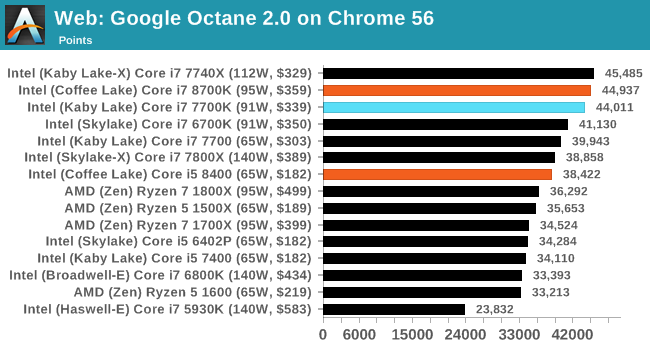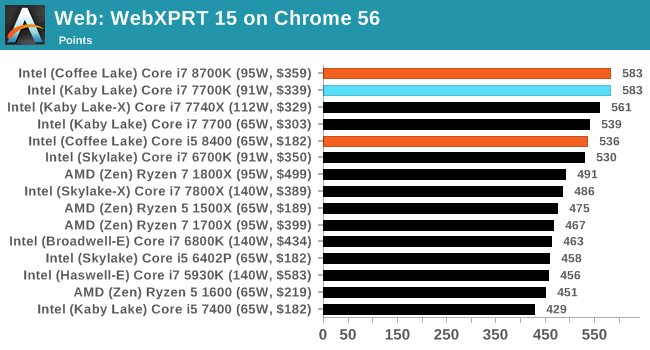The AnandTech Coffee Lake Review: Initial Numbers on the Core i7-8700K and Core i5-8400
by Ian Cutress on October 5, 2017 9:00 AM EST- Posted in
- CPUs
- Intel
- Core i5
- Core i7
- Core i3
- 14nm
- Coffee Lake
- 14++
- Hex-Core
- Hyperthreading
Benchmarking Performance: CPU Web Tests
One of the issues when running web-based tests is the nature of modern browsers to automatically install updates. This means any sustained period of benchmarking will invariably fall foul of the 'it's updated beyond the state of comparison' rule, especially when browsers will update if you give them half a second to think about it. Despite this, we were able to find a series of commands to create an un-updatable version of Chrome 56 for our 2017 test suite. While this means we might not be on the bleeding edge of the latest browser, it makes the scores between CPUs comparable.
All of our benchmark results can also be found in our benchmark engine, Bench.
SunSpider 1.0.2: link
The oldest web-based benchmark in this portion of our test is SunSpider. This is a very basic javascript algorithm tool, and ends up being more a measure of IPC and latency than anything else, with most high-performance CPUs scoring around about the same. The basic test is looped 10 times and the average taken. We run the basic test 4 times.

Mozilla Kraken 1.1: link
Kraken is another Javascript based benchmark, using the same test harness as SunSpider, but focusing on more stringent real-world use cases and libraries, such as audio processing and image filters. Again, the basic test is looped ten times, and we run the basic test four times.

Google Octane 2.0: link
Along with Mozilla, as Google is a major browser developer, having peak JS performance is typically a critical asset when comparing against the other OS developers. In the same way that SunSpider is a very early JS benchmark, and Kraken is a bit newer, Octane aims to be more relevant to real workloads, especially in power constrained devices such as smartphones and tablets.

WebXPRT 2015: link
While the previous three benchmarks do calculations in the background and represent a score, WebXPRT is designed to be a better interpretation of visual workloads that a professional user might have, such as browser based applications, graphing, image editing, sort/analysis, scientific analysis and financial tools.











222 Comments
View All Comments
risa2000 - Friday, October 6, 2017 - link
This actually makes sense. I wonder how Ian explains (even to himself) that additional 2 new cores in i7-8700K do not push the power envelope at all compared to i7-7700K. Is it because in Anandtech benchmark 8700K uses only 4 cores? Or uses 6 but throttles them down to stay in power limit?sonny73n - Friday, October 6, 2017 - link
I was also puzzled about some test results in this review but after reading thru the comment section, I conclude that this is indeed his worst review to date. He mentioned that he only had 3 days for this review. Maybe this is the reason.sonny73n - Friday, October 6, 2017 - link
I forgot to mention his lack of AMD comparisons among little mistakes here and there.DanNeely - Friday, October 6, 2017 - link
At a guess Anands temp test isn't using the bigger AVX sizes because at full load the hugely wide calculations use a lot more power than anything else; to the extend that by default they have a negative clock speed offset of several hundred MHz. I'm not sure how or if MCT shenanigans affect the AVX clock speed.Ian Cutress - Saturday, October 7, 2017 - link
You'd be surprised at how aggressively Intel is binning. We've said for a long while that Intel never pushes its chips to the limits in DVFS or frequency (like AMD), so if they were willing to make higher SKUs and commit to their usual warranty, it should be an easy enough task.Our power benchmark loads up all threads.
Ian Cutress - Saturday, October 7, 2017 - link
Is Paul/Igor testing at-wall power consumption at stock? That might add a bunch. Even the lower end CPUs seem out of whack there. Our power numbers are just for the CPU, not the at wall.Our numbers are derived from the internal calibration tools that the processor uses to determine its own power P-states, which in effect is directly related to the turbo. We run a P95 workload during our power run, and pull the data from the internal tools after 30 seconds of full load, which is long enough to hit peak power without hitting any thermal issues or PL2/PL3 states.
There seems to be a lot of boards that screw around with multi-core turbo this generation, which may also lead to higher power consumption numbers.
MingoDynasty - Thursday, October 5, 2017 - link
There is a typo in the article. 7700K has a TDP of 91W, not 95W.Ian Cutress - Saturday, October 7, 2017 - link
Intel played shenanigans with the 7700W TDP. They gave it as one value in the first briefings, then switched to the other just before launch, then switched back again after launch.mapesdhs - Tuesday, October 10, 2017 - link
I know it's only a typo, but I still had to laugh at "7700W TDP". ;D#EditingForATForums
W1nTry - Thursday, October 5, 2017 - link
There also seems to be a price change to the 1800x and 1700x which are as much as 100USD lower than what's reflected on the charts. I think that would factor in notably.